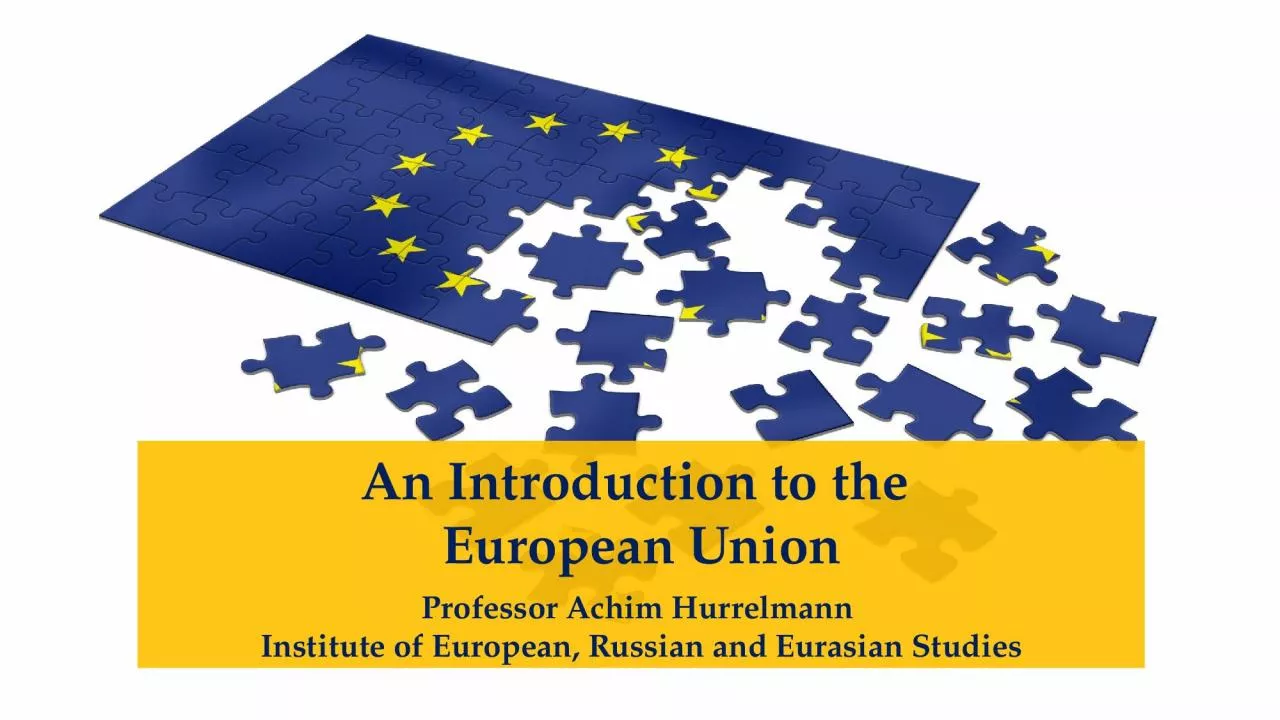

Professor Achim Hurrelmann Institute of European Russian and Eurasian Studies Member States Potential Candidate States European Union Member states and candidates for accession Origins of European integration ID: 1027641
Download Presentation The PPT/PDF document "An Introduction to the European Union" is the property of its rightful owner. Permission is granted to download and print the materials on this web site for personal, non-commercial use only, and to display it on your personal computer provided you do not modify the materials and that you retain all copyright notices contained in the materials. By downloading content from our website, you accept the terms of this agreement.
1. An Introduction to the European UnionProfessor Achim Hurrelmann Institute of European, Russian and Eurasian Studies
2. Member States (Potential) Candidate StatesEuropean Union: Member states and candidates for accession
3. Origins of European integration: Integration initiatives launched in Western Europe in aftermath of World War II; period marked by political and economic reconstruction, beginning of Cold WarInstitutional foundations of today‘s European Union: Three Communities created in 1950s: European Coal and Steel Community (ECSC), European Atomic Energy Community (Euratom) and European Economic Community (EEC), with six member statesThree trajectories of development: (1) Accession of more member states (“widening”); (2) transfer of more powers and decision-making autonomy to European institutions (“deepening”); (3) growing complexity of multiple, overlapping regional arrangements (“differentiated integration”)History of European integration
4. Original members: Germany, France, Italy, Belgium, Netherlands, Luxemburg1973: UK, Ireland, Denmark1981: Greece1986: Portugal, Spain1990: East Germany1995: Austria, Sweden, Finland2004: CEE countries, Cyprus, Malta2007: Bulgaria, Romania2013: CroatiaWidening integration
5. 1963/64: Court of Justice strengthens Community law against member states1985: Single European Act abolishes member-state veto in many policy areas, strengthens European Parliament1991: Maastricht Treaty creates European Union; lay groundwork for Euro; pushes integration beyond economics (foreign policy, home affairs)1997/2000: Amsterdam and Nice Treaties reform EU institutions prior to enlargement; incorporate Schengen agreement into EU treaties2007: Lisbon Treaty simplifies institutional structure, gives EU unified legal personality in force since 2009Since 2010: Succession of crises (Eurozone crisis, refugee crisis, Brexit) and rise of EuroscepticismDeepening integration
6. Differentiated integrationEuropean Union
7. EU governance: Core characteristicsMore than an international organization, less than a state: EU is combination of intergovernmentalism (member-state control) and supranationalism (pan-European mandate)Multilevel governance: EU makes binding laws in wide range of areas, but mainly framework laws specified by member states; member states charged with policy implementationPrecarious legitimacy: More democratic mechanisms than in any other international organizations, but limited citizen interest/participation and increasing Euroscepticism
8. InstitutionCompositionGovernance roleEuropean Council (Brussels)Member state leaders(intergovernmental)Defines legislative, executive objectivesEuropean Commission (Brussels)EU bureaucrats (supranational)Executive, some legislative functions Council of the European Union (Brussels)Member state ministers (intergovernmental)Legislative, some executive functionsEuropean Parliament(Strasbourg, Brussels)Elected MEPs (supranational)LegislativeCourt of Justice(Luxembourg)EU judges (supranational)JudiciaryCore EU institutions: A first overview
9. Summits of heads of state or government from all member states, permanent president (Donald Tusk)Discusses pressing issues; defines policy objectives; decides on institutional reform and key personnelUsually meets 5-10 times per year, makes decisions by consensus (few exceptions)European Council
10. One Commissioner per member state, responsible for specific portfolio, headed by president (Jean-Claude Juncker)Monitors implementation of EU law; manages EU programs and finances; initiates EU legislation; some front-line regulatory functonsSeeks to speak with one voice (internal divisions usually not reported to the outside)European Commission
11. One minister per member state; composition varies by policy field; presidency rotates between member states every six months (currently: Estonia)Must pass all binding EU laws; monitors Commission; executive role through national bureaucraciesDecides unanimously or per qualified majority (QMV)Also called “Council of Ministers” or just “Council” Council of the European Union
12. 751 elected members, organized in trans-national party groups, chaired by president (Antonio Tajani)Must pass EU laws in most policy areas (together with Council); scrutinizes of CommissionUsually decides by simple majorityEuropean Parliament
13. European People‘s Party (Christian Democrats) (EPP)Progressive Alliance of Socialists and Democrats in the European Parliament (S&D)European Conservatives and Reformists (ECR)Alliance of Liberals and Democrats for Europe (ALDE)European United Left – Nordic Green Left (GUE/NGL)Greens / European Free Alliance (Greens/EFA)Europe of Freedom and Direct Democracy (EFDD)Europe of Nations and Freedom (ENF)Party Groups in the European Parliament
14. Composition of the European Parliament
15. 28 judges, appointed by member states, chaired by president (Koen Lenaerts)Makes decisions on interpretation of EU law; most cases brought by national courts, EU institutions, or companies directly affected by EU decisionsMost decisions made in chambers of 3 or 5 judgesCourt of Justice
16. InstitutionCompositionGovernance roleEuropean Council (Brussels)Member state leaders(intergovernmental)Defines legislative, executive objectivesEuropean Commission (Brussels)EU bureaucrats (supranational)Executive, some legislative functions Council of the European Union (Brussels)Member state ministers (intergovernmental)Legislative, some executive functionsEuropean Parliament(Strasbourg, Brussels)Elected MEPs (supranational)LegislativeCourt of Justice(Luxembourg)EU judges (supranational)JudiciaryCore EU institutions: Another look